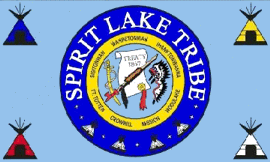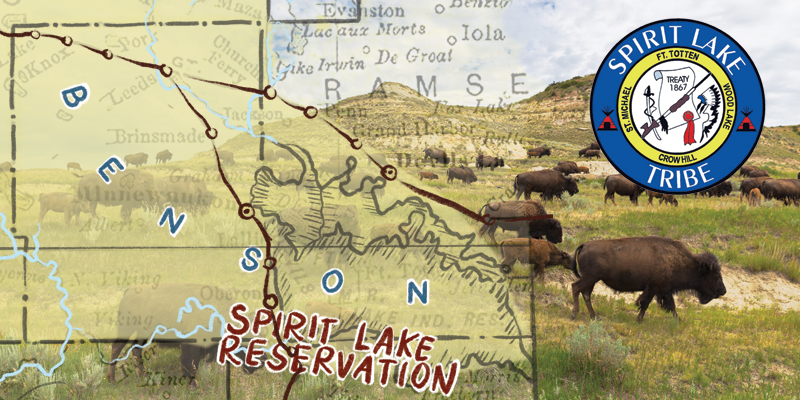
Echoes of the Prairie: Tracing the Ancestral Lands of the Spirit Lake Nation
The name "Spirit Lake Nation" evokes a powerful sense of place, a deep connection to a specific body of water and the lands surrounding it. Today, the Spirit Lake Nation is centered around Devils Lake (Mni Wakan, or "Spirit Water" in Dakota) in North Dakota, a vibrant and sovereign community. But to truly understand "where the Spirit Lake Nation lived" is to embark on a profound journey through time, traversing the vast prairies and azure waterways that once cradled their ancestors, and tracing the indelible marks left by treaties, conflict, and enduring resilience.
The story of the Spirit Lake Nation, primarily composed of the Sisseton and Wahpeton bands of the Dakota people (part of the larger Oceti Sakowin, or Seven Council Fires of the Great Sioux Nation), is not confined to a single fixed point on a map. It is a narrative of expansive ancestral domains, a nomadic existence intrinsically tied to the land, and a forced transformation that ultimately saw them concentrated onto a fraction of their former territory.

The Vast Canvas: Ancestral Homeland of the Dakota
Before the relentless westward expansion of European settlers, the Dakota people, including the Sisseton and Wahpeton bands, occupied a vast and ecologically rich territory spanning parts of what are now Minnesota, North Dakota, South Dakota, Iowa, and even into Canada. Their traditional lands were a mosaic of tallgrass prairies, oak savannas, dense forests, and countless lakes and rivers. This was their Makoche, their homeland, shaped by generations of intimate knowledge and spiritual connection.
The Sisseton (Sissetonwan, "Dwellers in the Fish Scales") and Wahpeton (Wahpetonwan, "Dwellers Among the Leaves") were two of the four eastern Dakota bands, often referred to as the Santee Dakota. Their traditional territories were generally located further east than their Teton (Lakota) and Yankton (Nakota) relatives. The Sisseton primarily ranged across central and western Minnesota, stretching into eastern North and South Dakota. The Wahpeton were concentrated in the forests and prairies of southeastern Minnesota, along the Minnesota River and its tributaries.
Their lives were intricately woven with the rhythms of the seasons. Spring brought the maple sap run and the gathering of medicines. Summer was a time for buffalo hunts on the open prairies, a communal endeavor that provided sustenance, shelter, and tools. Fall was for harvesting wild rice from the shallow lakes and preparing for winter, when families would often gather in more sheltered areas. Rivers like the Minnesota, Red, and James were vital arteries for travel, trade, and sustenance, teeming with fish and providing access to diverse ecosystems.
"For the Dakota people," explains Dr. Waziyatawin, a prominent Dakota scholar, "the land was not merely a resource to be exploited but a living entity, a relative, imbued with spiritual significance. Every tree, every rock, every body of water held stories and embodied the spirits of ancestors." This deep spiritual connection meant that their "living place" was not just a geographic location, but a sacred landscape where their identity, ceremonies, and very way of life were inextricably linked to the natural world.
The Shifting Sands: Treaties and Dispossession
The arrival of European fur traders in the 17th and 18th centuries marked the beginning of profound changes, but it was the relentless tide of American settlement in the 19th century that truly shattered the Dakota’s traditional way of life. The burgeoning population in the newly formed Minnesota Territory demanded land, leading to a series of coercive treaties that systematically dispossessed the Dakota of their ancestral domain.
The most significant and devastating of these were the Treaties of Traverse des Sioux and Mendota in 1851. Under immense pressure, and with promises of annuities (cash payments and goods) that were often delayed, diverted, or outright stolen by corrupt agents and traders, the Sisseton and Wahpeton, along with the Mdewakanton and Wahpekute bands, ceded vast tracts of land—approximately 24 million acres—in Minnesota and eastern South Dakota. In return, they were confined to a narrow strip of land along the Minnesota River.

This was the beginning of their concentrated living on reservations, a stark contrast to their previous expansive movements. The promises, however, were hollow. Annuities were consistently late, and the game that sustained them dwindled as settlers encroached. Starvation became rampant, leading to escalating tensions.
The Cataclysm of 1862: The U.S.-Dakota War and Forced Exile
The year 1862 marked a tragic turning point, often referred to as the U.S.-Dakota War or the Dakota Conflict. Driven to desperation by starvation, broken promises, and systemic corruption, a faction of the Dakota, led by figures like Little Crow, launched an uprising against the settlers and U.S. forces. While the war lasted only six weeks, its consequences for the Dakota were catastrophic and long-lasting.
Though not all Dakota participated in the fighting, and many actively sought to protect settlers, the U.S. government’s response was brutal and indiscriminate. Following the Dakota’s defeat, thousands of Dakota people, including many innocent women, children, and elders, were rounded up and held in concentration camps. A military tribunal sentenced 303 Dakota men to death, and on December 26, 1862, in Mankato, Minnesota, 38 Dakota men were publicly hanged in the largest mass execution in U.S. history.
The aftermath saw the complete expulsion of the Dakota from Minnesota. An act of Congress abrogated all treaties with the Dakota, and bounties were placed on their heads. Those who survived the executions and the brutal internment at Fort Snelling were forcibly marched or transported to barren reservations further west, often in chains. Many perished from disease, starvation, and exposure during these forced removals.
Among those expelled were many Sisseton and Wahpeton people. They were initially moved to reservations in what is now South Dakota, such as the Crow Creek Reservation, where conditions were horrific. It was during this period of immense suffering and displacement that a new, specific "living place" would be designated for some of them: Fort Totten.
Fort Totten: A New, Unwilling Home
The Fort Totten Military Reservation, established in 1867 on the south shore of Devils Lake (Mni Wakan) in what was then Dakota Territory, was initially a military outpost intended to protect settlers and control the Indigenous population. However, by 1870, the fort itself was repurposed. The U.S. government, seeking to consolidate and "civilize" the dispossessed Dakota, began to settle various bands, including a significant number of Sisseton and Wahpeton people who had survived the horrors of 1862 and subsequent removals, onto the lands surrounding the former fort.
This was not a choice, but a directive. They were placed on land that, while familiar in its prairie landscape, was a mere sliver of their ancestral domain and was now tightly controlled. The reservation, officially established in 1867 and later modified, became the designated home for what would eventually be recognized as the Spirit Lake Nation. The name "Spirit Lake" itself is a direct translation of the Dakota "Mni Wakan," referring to Devils Lake, which held spiritual significance for the Dakota long before the arrival of Europeans. Its fluctuating water levels and mysterious nature contributed to its sacred status.
Life on the reservation was arduous. The government’s policy was assimilation, aiming to eradicate traditional Dakota culture, language, and spiritual practices. Children were forced into boarding schools, often far from home, where their hair was cut, their language forbidden, and their culture suppressed. The Dawes Act of 1887 further fragmented tribal lands, allotting individual parcels to tribal members and opening up the "surplus" land to non-Native settlers, further eroding the communal land base and weakening tribal sovereignty.
Despite these immense pressures, the Spirit Lake people endured. They adapted, persevered, and found ways to maintain their identity and traditions, often in secret. Elders continued to pass down stories, language, and ceremonies, ensuring that the spirit of the Dakota people would not be extinguished.
The Spirit Lake Nation Today: Resilience and Reaffirmation
Today, the Spirit Lake Nation occupies the Fort Totten Indian Reservation in northeastern North Dakota, encompassing approximately 245,000 acres of land. The reservation is situated in Benson and Eddy counties, with its tribal headquarters in Fort Totten. The community numbers over 7,000 enrolled members, with many living on or near the reservation.
The question of "where they live" now extends beyond mere geography to encompass a vibrant, self-governing nation. The Spirit Lake Nation has established its own tribal government, courts, and police force. They are actively engaged in economic development, with the Spirit Lake Casino & Resort being a major employer and revenue generator, funding essential services for the community. They operate their own tribal college, Cankdeska Cikana Community College, dedicated to preserving Dakota language and culture while providing higher education opportunities.
Cultural revitalization is a powerful force. The Dakota language, once suppressed, is now being taught in schools and homes. Powwows, traditional ceremonies, and storytelling continue to affirm their heritage. The Spirit Lake Nation actively participates in inter-tribal affairs and advocates for tribal sovereignty, water rights, and the protection of their sacred sites.
The journey of the Spirit Lake Nation is a testament to the enduring power of a people deeply connected to their ancestral lands, even when forcibly removed and confined. Their history is etched with the pain of dispossession and the trauma of conflict, but it is equally defined by an unyielding spirit of resilience, adaptation, and the unwavering determination to reclaim and revitalize their cultural identity. From the vast prairies of their ancestors to the specific contours of Devils Lake, the Spirit Lake Nation continues to live, thrive, and tell their powerful story, ensuring that the echoes of their past resonate strongly into the future.


